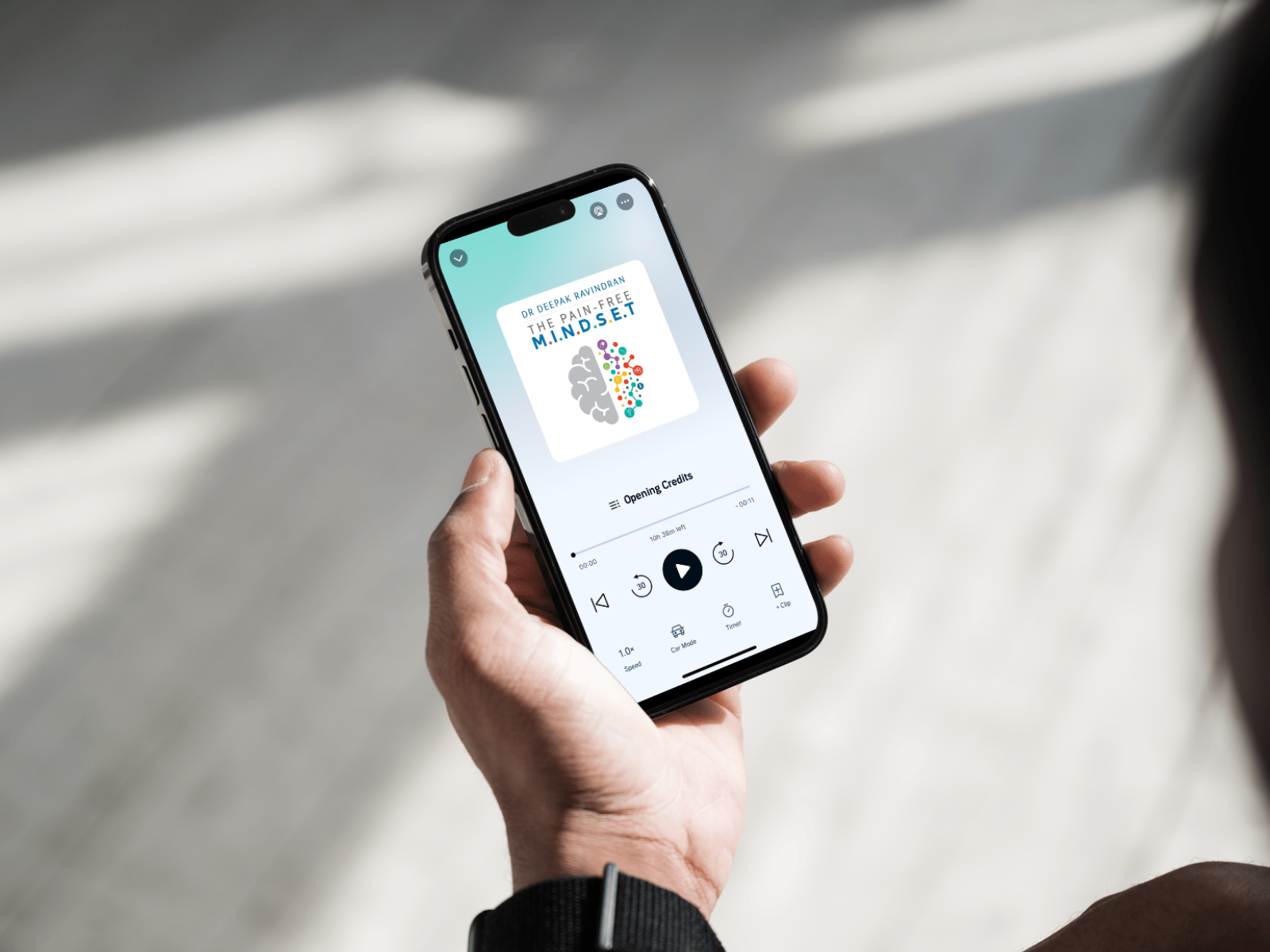
The Surprising Connection Between Hips and Jaw Pain
How adapting my holistic approach to treating TMJ Dysfunction transformed my results.
A must read for anyone still seeking answers to their persistent pain!

If I told you that most pain medication, injections and surgeries were not only ineffective at treating persistent (chronic) pain, but more than likely made it worse, would you believe me? No, I thought not.
Well how about if the person telling you was an NHS pain management consultant whose job it was to prescribe pain medication, injections and surgeries?
Would you be more likely to believe them?
In his newly released audiobook, misleadingly titled, The Pain-Free Mindset, Dr Deepak Ravindran expertly threads together shocking real-life stories with clinical evidence, to demonstrate why most current medical interventions fail to relieve persistent pain.
I say misleadingly titled because at first glance the title may suggest that pain is in our mind and if we just change our mindset it will go away. How many of us with persistent pain have been told that before? Thankfully, that is not the direction this excellent book goes in. The full title of the book gives us a better indication of its direction: The Pain-Free Mindset: 7 Steps to Taking Control and Overcoming Chronic Pain.
As an NHS consultant, our author, Ravindran, is uniquely qualified in musculoskeletal medicine, lifestyle medicine and pain medicine.
If, as he argues, pain medication, injections, and surgeries intended to relieve pain, are more often than not ineffective, why are these still the preferred courses of treatment for the most common persistent musculoskeletal pain conditions?
Dr Deepak Ravindran suggests the main reason is the misconception of how pain works. He asserts that the misguided assumption that pain must mean some form of tissue damage (nociceptive pain) leads physicians to either aim to dampen the pain experience with drugs or injections, or remove the “issue in the tissue” with surgery.
Neither of these approaches are usually effective, as both approaches assume nociception and fail to address how persistent pain actually works.
Dr Deepak Ravindran asserts that a significant number of healthcare professionals, including surgeons, have either not updated their understanding of pain science, or are worse still, stuck to their theories and interventions.
Ravindran argues that modern neuroscience now evidences that persistent pain is complex. Pain does not necessarily mean tissue damage. Similarly, higher levels of pain do not mean higher levels of damage.
He asserts that most persistent pain is a result of central sensitisation – an over-amplification of pain brought on my multiple factors, but more often than not, with no nociceptive influence whatsoever. Central sensitisation is a topic I have covered in my article How to relieve chronic pain – 5 essential reminders.
Ravindran references some excellent research throughout the book. He also quotes neuroscientists such as Professor Lorimer Moseley, whose brilliantly entertaining Tedx Talk tells his own story of being bitten by one of the world’s deadliest snakes, to explain central sensitisation, the complexity of persistent pain and how all parts of the brain are called upon to determine the level of pain we are likely to experience.
I was fortunate enough to meet Professor Moseley myself a couple of weeks ago when he retold the same story to many pain-care professionals, like myself at a seminar in London.
Moseley is part of the Flippin’ Pain™ Public Health Campaign initiative. The initiative, which Ravindran also references in The Pain-Free Mindset targets healthcare professionals. Their aim is to help us all understand more about how pain works in order for us to get better outcomes for the clients or patients we work with.
Here are a few short videos from the Flippin Pain team. I highly recommend having a look. I think the initiative is well named. It really does challenge our assumptions about pain, so it is best approached with a light heart and an open mind.
Much of this book reaffirms what I have studied and researched on persistent (chronic) pain for my qualifications. What I find really refreshing is that it is written by a clinical expert within the NHS. This is quite a step change.
You will see that Ravindran does not hold back. He lays out the evidence to explain why current misperceptions are leading to unnecessary and potentially damaging drugs, imaging, and surgeries.
In this book you will learn the neuroscience of how the brain amplifies pain. You’ll then learn strategies to tone down this amplification.
You will learn how pain medications are scored for both effectiveness and harm. That way you will be able to make a more informed decision or be able to confidently ask further questions when being prescribed certain drugs.
With Ravindran’s clear explanations and evidence, you will see how throw away remarks like “bone on bone,” and “there’s nothing showing on the x-ray, so there’s nothing to worry about,” are so misleading and potentially harmful.
Ravindran covers all the bases – how the gut microbiome, quality of sleep, and movement, all play a part in persistent pain.
Finally, Ravindran explores over thirty Mind/Body therapies, including breathworks, meditation, and of course myofascial release and massage, which can be explored as a safe and non-invasive alternative to conventional treatments such as pain medication, injections and surgery.
This is a well balanced book. Ravindran takes a compassionate approach to tackling a difficult and emotive topic. He makes a point not to endorse any particular therapy. Instead, encouraging the reader to have an open mind and be the judge themselves. He tries to balance arguments – such as massage has the potential to calm the nervous system; however, a rigorous massage will likely make things worse.
There are areas I would have liked to see him bring more to the fore. For example, he touched on fascia, our connective tissue. But he didn’t draw out what effect central sensitisation has on fascia or vice versa. Here, he could have referenced the wonderful research of Dr Robert Schleip for example.
That aside, this is an excellent book, which I have already recommended numerous times. The British Pain Society refers to chronic pain as The Silent Epidemic . If we are to have a positive impact on this or our overstretched NHS, then pain science education and lifestyle medicine, such as the mind-body therapies covered in this book, must surely all have a major role to play.
You can find the book in all good book shops. I enjoyed listening to the author narrate his book on Audible.
As well as Amazon, you can also find the book at Waterstones, Foyles, Blackwell’s, Wordery and WhSmith.
You can learn more about Dr Deepak Ravindran through his website deepakravindran.co.uk. He also has a Podcast and Youtube channel.

How adapting my holistic approach to treating TMJ Dysfunction transformed my results.

What is the best treatment for low back pain? Well it turns out it’s not drugs, injections or surgery – so what is it?

Pain and Cold Weather: Separating Fact from Fiction Home It’s that time of year! As the temperature drops, conversations about the link between pain and

Here are 5 essential reminders that we can turn to regularly to help us on our pain-relief pathway.

Should I Buy a Massage Gun? Are you feeling fatigued and sore after a long day of work? Do your muscles feel stiff and tight?

Volunteering as a complementary therapist has brought a very special and personal opportunity for me to say thank you. Today, Monday 12th April sees the